The white-tailed deer (Odocoileus virginianus) is one of Missouri’s most valuable wildlife resources (Figure 1). Each year, hunters spend more than six million hunter-days in the field pursuing the whitetail, contributing $1.1 billion annually to the Missouri economy and supporting over 12,000 jobs in the process. Hunting the white-tailed deer is a tremendously popular form of recreation that carries great traditions. Deer also provide other recreational opportunities, as well as aesthetic, economic and educational value.
Although private landowners are the stewards of this important wildlife resource in the state, the Missouri Department of Conservation provides the legal framework for successfully managing white-tailed deer populations. In addition to being influenced by hunting pressures within a given area, populations of whitetails are strongly affected by land-use practices and respond favorably to habitat management practices designed to improve food and cover conditions. An understanding of deer biology and ecology (the relationship of deer with their surroundings) is the first step towards successful management of the species.
This publication is the first in a series of white-tailed deer management guides for landowners and wildlife enthusiasts. The series provides research-based information to help landowners make informed decisions and achieve their management goals and population objectives for white-tailed deer on their properties.
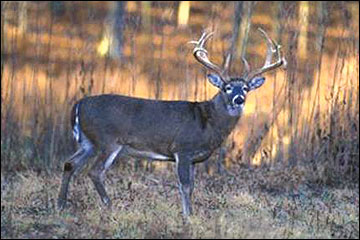 Figure 1. The white-tailed deer is the most popular game species in Missouri.
Figure 1. The white-tailed deer is the most popular game species in Missouri.
History of white-tailed deer conservation in Missouri
The history of white-tailed deer in Missouri shows the positive and negative influences humans can have on wildlife (Figure 2). In presettlement times, white-tailed deer were fairly abundant in Missouri, especially in the more fertile, diverse habitats of the northern part of the state. In areas of extensive mature forests, population densities were lower. Deer may have been locally abundant in areas where lightning fires and other factors had opened up the dense forest canopy. Natural enemies of deer, such as mountain lions and the timber wolf, played a significant role in regulating deer numbers and keeping them in relative balance with their habitat.
The influx of European settlers in the latter half of the 19th century coincided with a rapid decline in the deer population. Unrestricted market hunting and habitat destruction became severe limiting factors on deer, and herds began to decline drastically.
By the early 1900s, deer numbers had reached an extremely low point and the public became more concerned with preservation and conservation. Laws restricting the harvest of deer were passed in the early 1900s but were largely unenforced. By 1925, only about 400 deer were present in the state.
In response to the continuing population decline, the Missouri legislature closed the hunting season and made a concerted effort to enforce regulations. Game laws were enacted and law enforcement efforts were strengthened. During the same time, deer were brought to Missouri from Michigan and released on five refuges in the Ozarks region. In 1931, deer season reopened, resulting in a small harvest.
Significant efforts to restore the whitetail began in 1937, partially as a result of the formation of the Missouri Conservation Commission. The Commission closed deer season from 1938 to 1943. During this time, additional deer were stocked from Wisconsin and Michigan and regulations were enforced by professionally trained conservation agents to deter poaching.
By 1944, the statewide deer population had risen to 15,000 and, for the first time since the recovery efforts had been initiated, the state reopened deer season. The restoration and management efforts of the Conservation Commission together with solid support of private landowners and the general public enabled the spectacular comeback of the white-tailed deer in Missouri.
These early management activities promoted an increase in the deer population, which was followed by a renewed interest in deer hunting by people across the state. More recent management efforts have attempted to define optimal population levels and design hunting regulations to achieve them.
Humans have assumed the role of the major predator of the white-tailed deer. Through regulated hunting, adequate numbers of deer can be removed each year to keep deer herds in balance with their habitat. Current management by the Missouri Department of Conservation attempts to maintain deer populations at levels high enough to provide adequate opportunity for hunters and for people who enjoy watching deer but low enough to ensure a healthy herd and minimize problems.
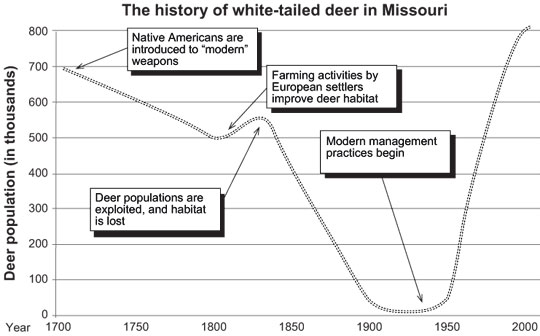
Figure 2. The influx of European settlers in the latter half of the nineteenth century coincided with a rapid decline in the deer population. (Source: Missouri Department of Conservation)
Biology and life history
White-tailed deer are ungulates, or hoofed mammals, belonging to the family Cervidae, the true deer that share such characteristics as deciduous antlers (except for two species), only males having antlers (except for one species), the same dental arrangement, reduced second and fifth toes, and a four-chambered ruminating stomach. Species within this family also include elk (Cervus elaphus), moose (Alces alces) and caribou (Rangifer tarandus). The two most closely related deer species are the white-tailed and mule deer (O. hemionus), both of which belong to the genus Odocoileus. For many years, the white-tailed deer was the only remaining native ungulate still thriving in Missouri; however, this has changed with the recent reintroduction of elk into the Ozarks region of the state.
White-tailed deer populations can be found in each of Missouri’s 114 counties. The species is quite adaptable to a variety of habitat types commonly found in each of the natural regions of the state (Figure 3), including bottomland and upland forests, woodlands, prairie and agricultural habitats and urban and suburban environments. Generally, deer are associated with a mosaic of several different habitat types, particularly where an adequate food supply and brushy cover are available.
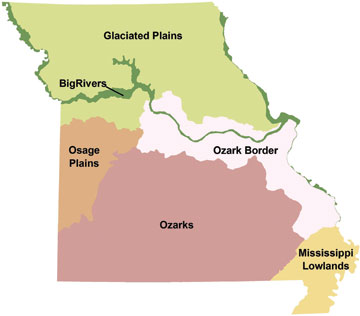 Figure 3. Each of the state's natural regions supports deer populations. Deer from the northern glaciated plains, however, tend to be heavier and to have larger racks. (Source: Missouri Department of Conservation)
Figure 3. Each of the state's natural regions supports deer populations. Deer from the northern glaciated plains, however, tend to be heavier and to have larger racks. (Source: Missouri Department of Conservation)
Coloration
The coloration of the whitetail has a noticeable seasonal variation. During the summer, deer are reddish-brown and their coats are relatively thin, less than 1/4 inch thick (Figure 4a). By August or September, they shed their summer pelage, or coat, and replace it with a thick, brownish-grey winter coat that is sometimes more than 1 inch thick (Figure 4b). The winter pelage is made up of short underfur and outside guard hairs. The molt, or shed, cycle begins again in April when deer start to grow their summer coat. This continual shedding and regrowth requires substantial amounts of protein and energy throughout the year. Fawns normally lose their spotted coloration after three or four months, with the growth of their winter coat.
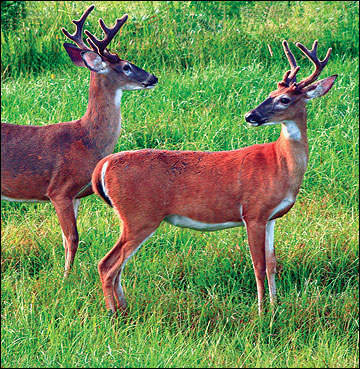
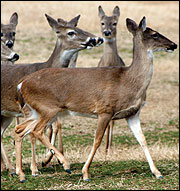
Figure 4. The color and thickness of a deer's coat changes with the seasons: (left) In summer, it is reddish-brown and relatively thin, less than 1/4 inch thick. (right) In winter, it is brownish-grey and may be more than 1 inch thick.
External glands
White-tailed deer have four sets of external glands that are primarily used for communication (Figure 5). Gland secretions can be used to describe an animal’s social status, breeding condition and health. The most recognized glands are the tarsal and metatarsal glands. The tarsal glands, located on the inner portion of the hind legs, serves to identify individuals. The metatarsal glands, on the outer, lower portion the hind legs, may help in regulating the animal’s body temperature. Interdigital glands, located between the hooves, probably leave scent trails for other deer to follow. Preorbital glands function as tear glands and may relay sex and social hierarchy when rubbed on branches.
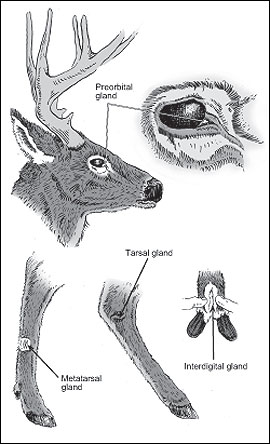 Figure 5. Deer have four sets of external glands used primarily for communication. Secretions can describe an animal's social status, breeding condition and overall health.
Figure 5. Deer have four sets of external glands used primarily for communication. Secretions can describe an animal's social status, breeding condition and overall health.
Senses
Deer have a keen sense of smell, which they rely on to detect danger, identify other animals and locate food. Deer also have large, cupped ears that can rotate, giving them an acute sense of hearing. Although their eyesight is not as developed as these other senses, they can readily detect motion over a wide field of vision. Their eyes possess a rod-to-cone ratio that enhances their ability to see in low levels of light. Thus, deer are believed to be diachromatic (possess two-color vision).
Sounds
Although deer do make several different vocalizations, when compared to smell and visual cues, sounds play a relatively minor role in deer communication. Sounds that are important include bleating or “mewing” by fawns to summon the doe. Bucks also occasionally bleat or grunt when chasing does during the rut. However, the most familiar deer sounds are the grunts, snorts and stomping used as an alarm call by a frightened animal.
Reproductive cycle
The reproductive cycle begins with the onset of the rut, which is the mating period. The rut is triggered by decreasing day-length, which initiates the estrous cycle in the female and causes an increased production of testosterone in the male. The rut occurs in several phases during the fall and winter. Most breeding in Missouri occurs during November but may extend from October through January.
As the days grow shorter, bucks become more aggressive and begin to rub their antlers on trees and spar with other bucks in the vicinity (Figure 6). Bucks establish a dominance hierarchy and begin scraping activity, which is one way they mark their breeding territory. To form a “scrape,” the buck scrapes the ground with its front hooves until the vegetation is removed and bare ground is exposed. Bucks and does will both urinate on bare ground and allow the urine to run down the inside of their legs over scent glands.
White-tailed deer are polygamous breeders; one buck may mate with several does during a breeding season. A long-held belief that the dominant, or alpha, male will generally do most of the breeding within a given area has been proven to be false. In fact, a large proportion of bucks of all ages participate in breeding activities. Additionally, it has been shown that as many as 25 percent of twin fawns have been sired by different fathers.
The gestation period for white-tailed deer is slightly less than seven months, generally between 190 and 210 days. Fawning normally extends from May through July, with the peak in late May through June.
In Missouri, most adult does produce twin fawns each year (Figure 7). The number of fawns that are born and survive each year depends on a number of factors, including the age and condition of the mother, the density of deer in the area, and the availability of natural forage and agricultural crops, as well as on the density of predators.
In addition, about 20 to 30 percent of fawns will breed at 6 months of age and produce offspring by the time they are a year old. However, as deer densities have increased over the past several decades, the percentage of fawns that breed has slowly declined each year.
Pregnancy rates of deer have been studied in Missouri. The data suggest that pregnancy rates are nearly equal for yearling does and does 2-1/2 years and older but are much lower for younger deer (Table 1).
At birth, buck fawns will slightly outnumber females. Newborn fawns weigh 5 to 7 pounds, although males tend to be larger than females. Fawns are mobile and able to stand and walk on spindly legs during their first day of life but do not ordinarily begin following their mother until they are about 1 month old. During this early period, they are visited frequently by the doe for feeding. Many people believe that a fawn has been abandoned when they find one unattended, but the doe is almost always feeding or resting nearby. These fawns should not be disturbed or taken home to be raised.
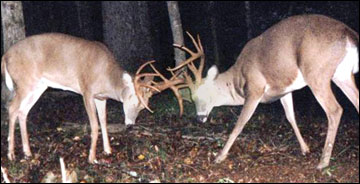 Figure 6. During the breeding season, or rut, bucks may battle for dominance.
Figure 6. During the breeding season, or rut, bucks may battle for dominance.
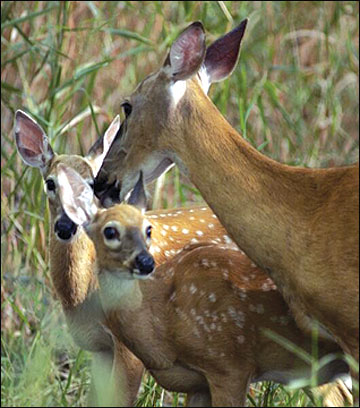 Figure 7. Most adult does produce twin fawns each year.
Figure 7. Most adult does produce twin fawns each year.
Table 1. Regional pregnancy rates.
| Natural division | Age of deer | Number sampled | Percent pregnant | Avgerage number of offspring |
|---|---|---|---|---|
| Glaciated plains | Fawn | 266 | 32 | 0.43 |
| Yearling | 161 | 93 | 1.74 | |
| Adult | 247 | 94 | 1.86 | |
| Mississippi lowlands | Fawn | 6 | 50 | 0.83 |
| Yearling | 2 | 100 | 1.50 | |
| Adult | 10 | 100 | 2.19 | |
| Ozark border | Fawn | 108 | 26 | 0.34 |
| Yearling | 69 | 94 | 1.71 | |
| Adult | 133 | 94 | 1.68 | |
| Osage plains | Fawn | 36 | 50 | 0.67 |
| Yearling | 25 | 88 | 1.67 | |
| Adult | 50 | 94 | 1.68 | |
| Ozarks | Fawn | 122 | 21 | 0.28 |
| Yearling | 77 | 89 | 1.51 | |
| Adult | 219 | 94 | 1.78 | |
| Statewide | Fawn | 538 | 30 | 0.40 |
| Yearling | 337 | 90 | 1.67 | |
| Adult | 659 | 94 | 1.81 |
Pregnancy rates of whitetails, based on the collection of fetuses in road-killed does and grouped by the state’s natural regions, are nearly equal for does at least 21/2 years old and yearlings, while rates for younger deer are markedly lower. (Source: Missouri Department of Conservation)
Antler growth
The composition of antlers depends on their stage of growth. Growing antlers are composed of 80 percent protein and 20 percent ash. Hardened antlers are about 63 percent ash, 22 percent calcium, 11 percent phosphorus and 4 percent organic matter. Younger bucks’ antlers tend to be more dense and older bucks’ antlers more porous.
The small antlers on male fawns are usually referred to as buttons. Bucks get their first noticeable antlers at 1-1/2 years of age, when they are yearlings. Depending on the nutritional quality of the habitat, a yearling buck may have 10 or more antler points. Generally, older animals have heavier, better developed antlers than younger animals.
Bucks normally shed their antlers during the late winter each year and grow a new set between late spring and early fall. The time of antler-drop may vary, but in an average season, some bucks shed their antlers in late December and most have shed by early March. Shed antlers are often difficult to find in the woods because they have a high protein content as well as an abundance of calcium phosphate and are quickly consumed by rodents.
Once a deer sheds its antlers, new growth starts immediately, though visible antler growth is sometimes not apparent for several weeks (Figure 8a). Throughout the summer, the antlers are equipped with a very rich blood supply and are covered with a hairlike membrane commonly known as velvet (Figure 8b). While “in velvet,” antlers are particularly vulnerable to injury, and cuts or bruises suffered at this time often result in deformed antlers (Figure 9). By late August or early September, antler growth is completed, antlers become solid and hard, and the velvet dries and sloughs off or is rubbed off. Healthy bucks maintain polished antlers throughout the breeding season (Figure 8c).
 Figure 8. Antler growth: (top) buck with new antlers emerging, (middle) buck in velvet and (bottom) mature buck in the fall.
Figure 8. Antler growth: (top) buck with new antlers emerging, (middle) buck in velvet and (bottom) mature buck in the fall.
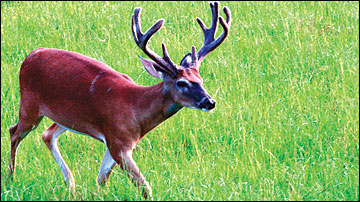
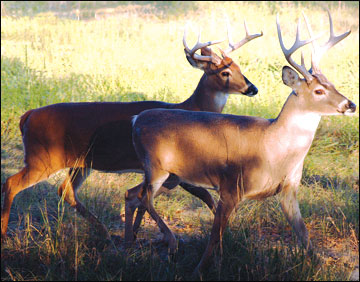
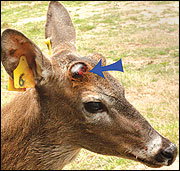 Figure 9. A damaged antler pedicle (top) can result in nontypical antler growth (bottom).
Figure 9. A damaged antler pedicle (top) can result in nontypical antler growth (bottom).
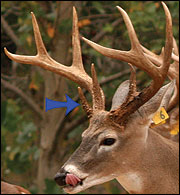
Deer nutrition and food habits
White-tailed deer are herbivores and are a ruminant species. This means they have a compound, four-chambered stomach that allows plant materials to be digested (Figure 10).
Like cattle, deer regurgitate food from their first stomach to “chew the cud,” which aids in the digestive process. As ruminants, deer are able to eat a variety of foods, including many foods that are indigestible to humans and other nonruminants.
Once thought to be exclusively browsers, primarily selecting twigs, deer actually include leaves, bark and herbaceous material such as grasses, weeds and soft-stemmed plants in their diets. They may also eat acorns and other nuts, fruits, mushrooms, algae and mosses when available.
Although deer eat a variety of foods, they are selective feeders and seek out plant species that offer the most nutrition during a particular season of the year. Foods eaten readily in one area may not be eaten in another area due to differences in soil, succulence, availability of more preferred food, deer numbers and other factors. In addition, deer may browse specific foods more heavily on burned than unburned areas and on fertilized than unfertilized areas.
Deer have been documented to feed on more than 600 types of plants. In areas that are predominately wooded habitats, deer rely on natural foods such as grape vines, green briar, Virginia creeper, oak sprouts, clovers, prickly lettuce and both hard and soft mast, such as acorns and persimmons. Studies in the agricultural areas of Missouri indicate that row crops, such as corn and soybeans, can comprise about 40 percent of a deer’s diet. During the late winter when crops are not available, deer use native forages and both hard and soft mast. Well-fertilized agricultural crops and nursery stock are often browsed severely in areas with a high deer density. Preferences for specific food items are a reflection of food availability at a particular time.
Deer prefer a variety of agricultural crops, including grains and vegetables. Some deer favorites are listed below.
- Soybeans
Green leaves are eaten from germination to yellowing; pods are eaten during the growing season and throughout the winter if not harvested. - Corn
Silk is eaten in June and July (during the silking-tasseling stage of growth); dented corn is eaten during the fall and winter. - Grain sorghum
Grain sorghum is eaten from the dough stage (70 days after planting) through the summer. - Wheat
Winter wheat is eaten from germination (in September or October) until it bolts (matures) in the spring. - Alfalfa and clover
Alfalfa, clover and other species of legumes are eaten after germination and whenever they are available throughout the year. - Sunflowers
Sunflowers are eaten from germination until the crop matures.
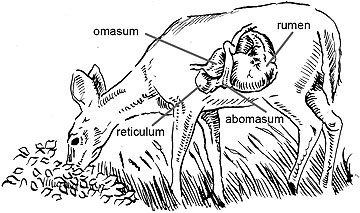 Figure 10. As ruminants, white-tailed deer have a four-part stomach containing microbes that break down cellulose and ferment carbohydrates, which provides energy and nutrients.
Figure 10. As ruminants, white-tailed deer have a four-part stomach containing microbes that break down cellulose and ferment carbohydrates, which provides energy and nutrients.
Deer weight and growth patterns
The quality of the soils and available nutrients in an area greatly influence the size of deer. Deer from northern parts of Missouri generally have larger body sizes than their southern counterparts because the superior soils and more abundant agriculture in the north provide deer with foods that offer a higher quality of nutrition (Table 2).
Deer often experience a loss of body condition during the winter. Does prioritize energy needs for the spring and summer, foregoing weight gain to invest in fetal growth and development of fawns. Does begin to regain weight in the late summer after fawns are weaned. Bucks will typically lose weight during the breeding season but will regain it during the spring and summer.
Table 2. Average dressed carcass weights (pounds).
| Region | Age of deer | Female | Male |
|---|---|---|---|
| Glaciated plains | Fawn | 67.6 | 72.1 |
| Yearling | 100.7 | 123.5 | |
| Adult | 111.7 | 154.8 | |
| Mississippi lowlands | Fawn | 48.0 | 54.0 |
| Yearling | 77.9 | 93.9 | |
| Adult | 87.4 | 128.2 | |
| Ozark border | Fawn | 51.7 | 58.2 |
| Yearling | 84.8 | 101.0 | |
| Adult | 92.6 | 132.7 | |
| Ozarks | Fawn | 47.0 | 53.2 |
| Yearling | 76.9 | 86.7 | |
| Adult | 86.5 | 125.2 |
Source
Missouri Department of Conservation
Home range sizes and deer movements
The size and shape of a deer’s home range depends on the quality of the habitat, deer density within the area, time of year, and age and sex of the deer. Deer living in more diverse, higher quality habitats are able to satisfy all their daily requirements in a smaller area, while deer living in less diverse, lower quality habitats often have to travel greater distances to locate suitable food and cover.
In general, deer movements and patterns of habitat use are influenced most by the availability of both food and cover. Deer living in diverse habitats with a large percentage of edge and an even distribution of food and cover tend to have smaller home ranges. Because of seasonal changes in the availability of food and cover, home range sizes generally decrease during summer and become larger during the fall. Bucks tend to have larger overall home ranges than does.
Relationship between food supply and population density
The relationship between food supply and population density and their effects on antler development and reproduction are often misunderstood. Overpopulation can occur even when deer numbers are not extremely high. When more deer are present than the available food can support, the herd is overpopulated and the habitat and individuals within the population suffer.
The degree to which deer browse certain shrub and tree species can be used as an indicator of deer population levels and winter severity. Some species of sumac and dogwood may be readily consumed by deer. Eastern red cedar and hickory are considered starvation foods and are usually only browsed when populations are high during severe winters.
In habitats with inadequate levels of nutrition, parasite loads may increase, buck and doe body weights will decrease, and deer may show obvious signs of poor antler development and lowered reproductive rates.
As a deer population continues to increase beyond its food supply, the overall health of the herd often declines and natural mortality increases. In addition, complaints of deer damage to agricultural crops and forest reproduction often rise, as does the risk of deer–vehicle collisions.
Disease does not typically account for a large percentage of whitetail mortality. However, periodic outbreaks of diseases such as epizootic hemorrhagic disease (EHD), can impact local populations. Mortality rates during these events can be from 10 to 50 percent of the population.
Population dynamics
Deer populations increase, decrease or remain stable based on the balance between reproduction and mortality. In Missouri, deer reproductive rates are generally high, and, in the absence of predators, mortality of adult deer is relatively low. Therefore, hunting is the primary factor governing deer abundance in rural areas.
Studies have shown that, in the absence of disease, fawn mortality during the first six months of life may exceed 40 percent. Without hunting, the annual mortality of deer older than 6 months of age is less than 5 percent.
Biological carrying capacity
As a deer herd increases, it eventually reaches and then exceeds the land’s biological carrying capacity — the maximum number of deer a habitat can support on a sustained basis. When deer numbers exceed the carrying capacity of the land, heavy browsing occurs and the physical condition of the deer degenerates, resulting in lower reproductive and survival rates. Due to the increased browsing, habitats are altered for many other wildlife species and are often slow to recover. The biological carrying capacity of an area is dynamic and can change on a yearly or even seasonal basis due to habitat improvements or to environmental conditions, such as a catastrophic crop or mast failure or a drought.
Cultural carrying capacity
Many habitats found throughout the state are able to provide deer with an almost unlimited supply of food. In many locations of northern Missouri, deer populations are well below the land’s biological carrying capacity. However, deer numbers may exceed the cultural carrying capacity — the number of deer the public will accept in a given area — which is exhibited by intolerance of severe crop damage or unacceptable numbers of deer–vehicle collisions. Without hunting, deer populations in agricultural habitats often reach cultural carrying capacity long before reaching the biological carrying capacity (Figure 11).
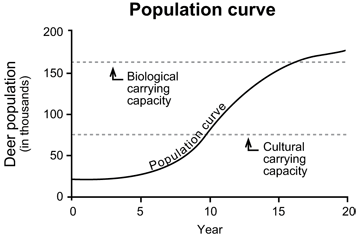 Figure 11. This deer population curve depicts the level when a population theoretically reaches cultural carrying capacity and increases to the point of reaching biological carrying capacity.
Figure 11. This deer population curve depicts the level when a population theoretically reaches cultural carrying capacity and increases to the point of reaching biological carrying capacity.
Harvest regulation
Harvest regulation is an essential part of sound management principles for white-tailed deer, not only to keep deer populations in relative balance with their food supply but also to keep populations in relative balance with the cultural carrying capacity. Where food is abundant and deer are healthy, a sustained but regulated harvest maintains healthy conditions and prevents overpopulation. In areas where deer are overabundant and food supplies are limited, increased harvests of antlerless deer may be necessary to prevent further damage to the habitat and a decline in deer quality.
Regulated either-sex harvests are necessary for proper herd management. Buck harvest alone cannot control a growing population. A reasonable harvest of bucks and does will assure a healthy population for the future.
Missouri is home to about 1.4 million deer. Deer abundance varies across the state, depending on the quality of the habitat and hunting patterns in an area. Hunting is the leading cause of deer mortality in most of the state. Each year hunters take about 40 to 70 percent of the antlered bucks and up to 25 percent of the does. Thus, hunting is the primary factor that governs deer abundance.
Hunting mortality of does is the single most important factor that governs whether a population increases or decreases. Due to the fact that one buck can breed with many does, the buck segment of the population can remain at lower levels without affecting reproductive rates. This can be shown by simulating a population of deer under various buck and doe harvest rates. For instance, a harvest of 10 percent or 40 percent of the bucks from a herd will produce very little difference in the overall growth rate of the population; however, similar harvests of does would affect the growth of the population.
If hunting mortality is eliminated (with other mortality and reproductive factors remaining the same), a deer population increases at a very rapid rate, nearly quadrupling in size in a matter of 10 years. However, growth at this rate could not continue indefinitely. As the population increases, it will eventually reach and exceed the land’s biological carrying capacity (Figure 11).
Proper management of a deer population is accomplished by regulating harvests to keep deer populations below biological and cultural carrying capacity, and managing habitats through sustainable practices to make an area more favorable to deer.
The appropriate level of deer harvest can be determined only after a variety of information on the population is obtained. Managing a population is difficult without knowledge about the sex and age ratio, productivity, and condition of the herd.
Controlling deer damage
Depredation to nurseries, vineyards, ornamental plants and orchards, as well as commercial agricultural crops, can be severe enough to cause economic damage. Orchard losses are usually greatest to small trees, which often have to be replaced several times because of severe browsing. In addition, damage to natural or planted trees on forest land, which is often overlooked, can be serious.
Deer damage is usually most severe in areas where deer population densities are high and where small agricultural fields, orchards, vegetable gardens and vineyards are interspersed and adjacent to areas that provide high-quality cover. Refer to MU Extension publication MP685, Controlling Deer Damage in Missouri, for more information on preventing and controlling damage caused by white-tailed deer.
Conclusion
White-tailed deer are one of Missouri’s most valuable natural resources. An understanding of their ecology and seasonal habitat needs is the first step toward implementing management techniques that successfully meet your particular objectives.
Subsequent guides in this series provide information on habitat requirements, evaluation and management techniques; population and harvest management strategies; quality deer management (QDM) program implementation strategies; and collecting appropriate information that can be used to make informed decisions on implementing deer management that meets your overall objectives.
Photo credits
Missouri Department of Conservation, Jason Sumners and Emily Flinn.